San Diego, famous for its stunning beaches and parks, is also home to a wide range of spider species. While some of these eight-legged creatures pack a venomous punch, others are just harmless artists spinning webs under the sun. These spiders, each unique in behavior and looks, play a vital role in San Diego’s diverse ecosystem. So, next time you’re out with your dog or just lounging in the garden, being aware of the spiders around might put your mind at ease.
In this article, we will go over 8 spiders you may come across in San Diego. We’ll further divide them into venomous and non-venomous species so that you know which spiders to steer clear of and which ones to let be.
Venomous Spiders in San Diego
Heading outdoors in San Diego? While many spiders in the area are harmless, there are a few venomous ones you might want to be cautious around.
1. Black Widow (Latrodectus hesperus)

Of course, one of the most famous venomous spiders in the San Diego area is the black widow.
©Sari ONeal/Shutterstock.com
Probably one of the most famous spiders in the United States, including in San Diego, is the black widow. Sporting a jet-black shade and a standout red hourglass mark on its belly, it’s not easy to miss. The females, measuring up to half an inch long, are around twice the size of the males. These spiders love warm spaces, and you might find them in both cities or farms. Black widows are experts at crafting webs and usually choose hiding spots beneath old furniture or inside woodpiles.
Like most other spiders, black widows generally eat insects, but they also eat other arachnids. Notably, the female black widow may also eat the male spider during sex, hence the “widow” in its name.
Note: The black widow’s venom is notably powerful and is considered to be 15 times more potent than that of a rattlesnake. A bite can cause muscle pain, nausea, and difficulty in breathing. And while fatalities are very rare, young children, the elderly, and those with compromised immune systems are at greater risk.
2. Brown Widow (Latrodectus geometricus)
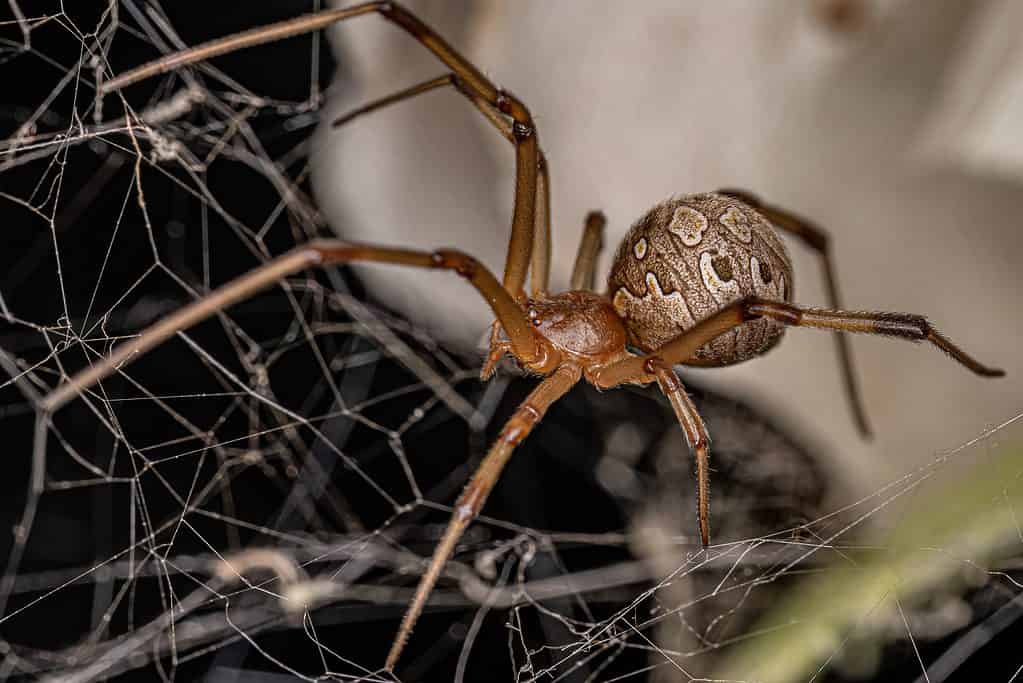
Another spider you should steer clear of in San Diego is none other than the brown widow, which looks very similar to the black widow.
©Vinicius R. Souza/Shutterstock.com
You could look at the brown widow as the black widow’s lighter-shaded cousin. While these two spiders might look similar, the brown widow sports shades from tan to dark brown and sometimes even gray. Just like the black widow, the brown widow has an hourglass mark, usually bright orange or yellow, under its belly. This spider also boasts striped legs. The female brown widows are typically 0.3 to 0.5 inches long, making them much larger than their male counterparts, which measure about 0.1 to 0.2 inches.
Brown widow spiders love tropical climates and choose secluded places, especially around homes, woody vegetation, or buildings. You might find them hiding in dark corners or crevices.
As for food, insects are their go-to. Using their webs, these spiders trap a variety of bugs, wrap them up in silk, and then enjoy their meal.
Note: The venom of the brown widow spider is similar in potency to the black widow. However, they tend to inject less venom when they bite. So, while symptoms might be milder, individuals may still experience pain, muscle spasms, and general malaise, so immediate medical attention is advised.
3. Desert Recluse (Loxosceles deserta)
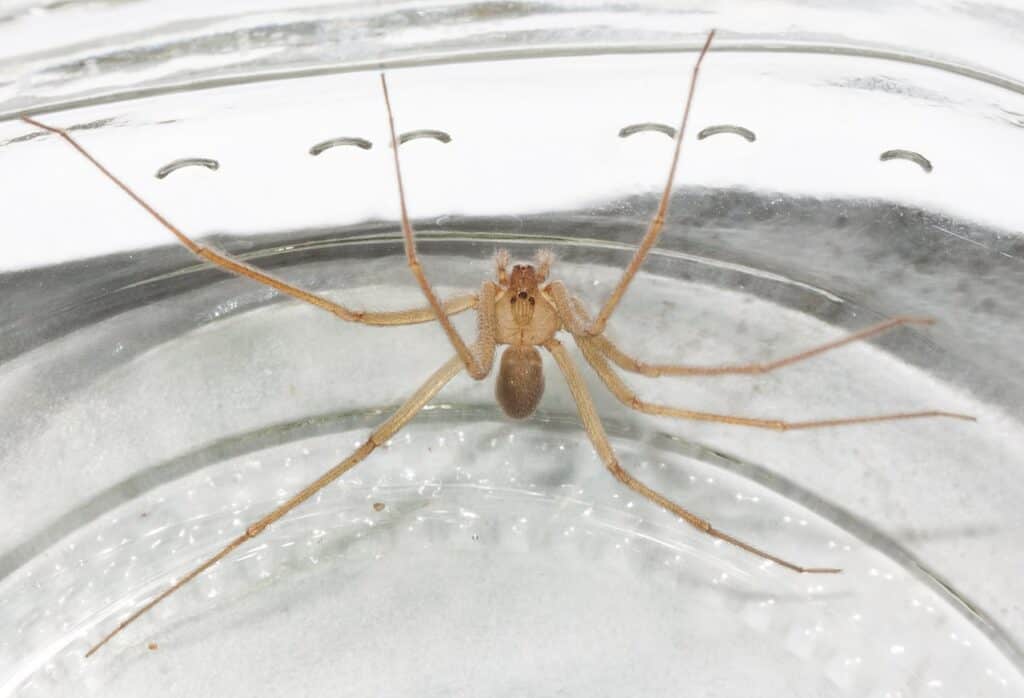
The third most venomous spider in San Diego is the desert recluse, which can cause necrotic skin lesions.
©DesertTrip / CC BY-SA 4.0, via Wikimedia Commons – Original / License
The desert recluse spider stands out in the spider world because, unlike most spiders, it only has six eyes. A member of the Sicariidae family, this spider is usually tan to yellowish-tan in color and about ½ inch in length. But the desert recluse can span 1.5 to 2 inches when its legs are stretched out. A notable part of this spider’s appearance is its unique fiddle-shaped mark on its body.
The desert recluse prefers to reside in quiet areas with lots of plants or even pack rat dens. This spider is very rarely found indoors.
Interestingly, desert recluse spiders don’t use their webs to catch food. Instead, they actively hunt small insects. However, they’re not too picky and won’t mind eating dead bugs, either.
Note: Although their venom is potent enough to subdue their meals, a bite from a desert recluse is not generally fatal. Still, be careful, as their bite can cause necrotic skin lesions, where the tissue around the bite dies and leaves a deep, scarring ulcer. Systemic reactions can include fever, chills, and rash. While deaths from a recluse spider bite are extremely rare, the wound can take a long time to heal and may require medical intervention.
4. Tarantulas (Theraphosidae)

There are two types of tarantulas that roam around in San Diego, both of which are venomous but not overly dangerous.
©Adam Mustafa/ via Getty Images
The two types of tarantulas you may run into in San Diego are the California black tarantula and the California bronze tarantula.
Tarantulas are pretty hard to miss because of their huge, hairy bodies. They can come in a wide range of colors, and some can even grow up to 2 inches long! All North American tarantulas are ground-dwellers, and you’ll usually find them in dry, well-drained soils in desert and grassland habitats.
Unlike most other spiders you may be more familiar with, tarantulas are active hunters and do not lie waiting in webs for their prey to come to them. Their hunting technique involves grabbing their prey and injecting paralyzing venom. While most tarantulas will generally eat insects, bigger spiders might even eat frogs, bats, and even snakes!
Note: The good news is tarantula venom is not as dangerous and powerful as some of the other venomous spiders on this list. If bitten by a tarantula, expect it to feel like a bee sting. Just like a bee sting, expect some swelling and redness in the area as well.
Non-Venomous Spiders in San Diego
Time to breathe a sigh of relief. Now, let’s discuss some spiders that, while they may be scary at first glance, are mostly harmless. Note that some of these spiders technically do have venom, but they are not dangerous to humans at all!
5. Johnson’s Jumping Spider (Phidippus johnsoni)
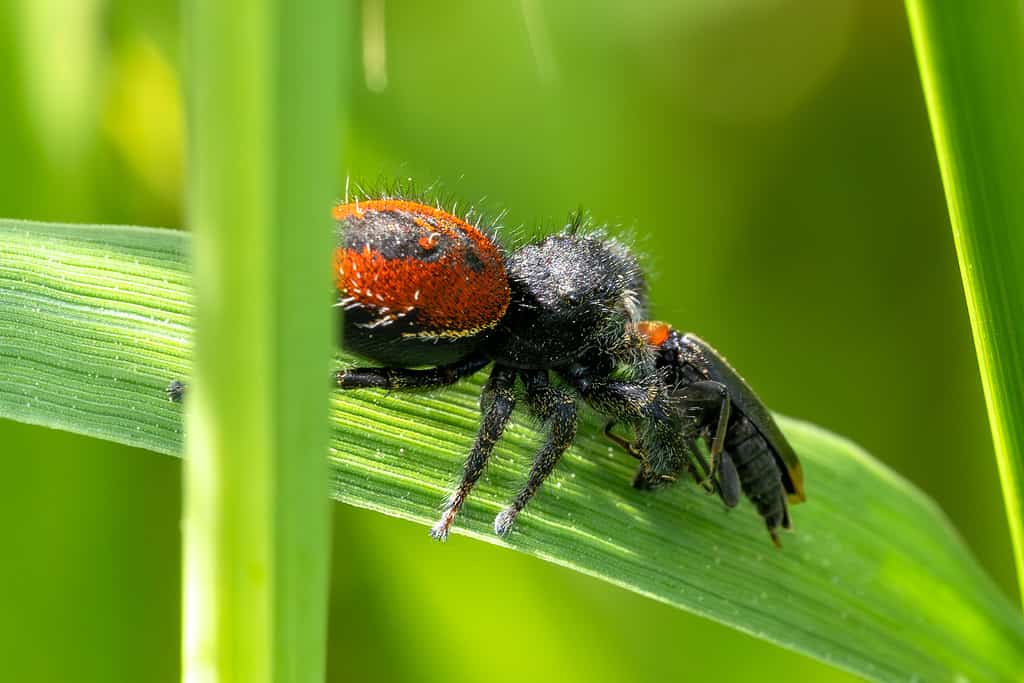
One of the most common spiders you’ll see in San Diego is the Johnson’s jumping spider, which can jump as far as five times its size!
The Johnson’s jumping spider, a common sight in San Diego, boasts brilliant colors of black, red, and white and is roughly a centimeter long (about 0.4 inches) as an adult. While both sexes have that signature bright red body, the females have a unique black stripe on their abdomen. Interestingly, despite their small size, Johnson’s jumping spiders have strong front legs that allow them to make impressive jumps as far as five times their size.
Unlike most spiders we are familiar with, Johnson’s jumping spiders don’t wait in webs for their prey. Instead, they actively roam places like gardens, beaches, forests, and fields during the day, actively hunting insects like flies, bugs, and even other spiders. They use their powerful jumping skills to pounce on their prey.
6. Orb Spiders (Araneidae)
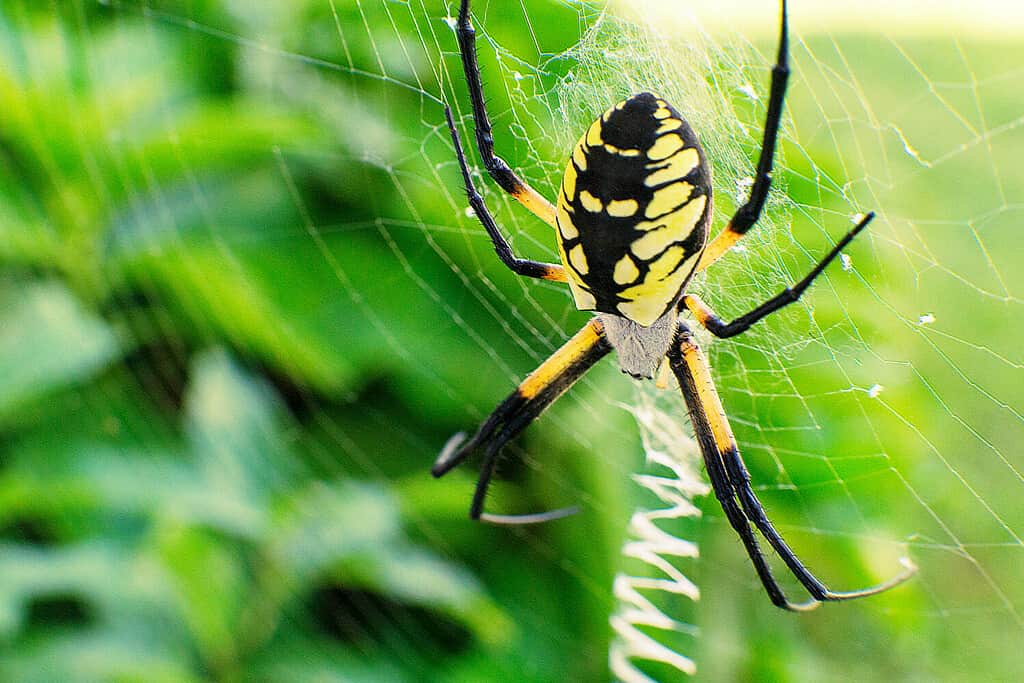
You can find many different types of orb spiders in San Diego, like the black and yellow garden spider (pictured).
©Theodore P. Webb/Shutterstock.com
Orb spiders are quite the sight in San Diego, with species like the spotted or crossed orb-weaver (Neoscona crucifera) and the black and yellow garden spider (Argiope aurantia) standing out. The crossed orb-weaver immediately catches the eye with its brown or reddish-brown hue. On the other hand, the black and yellow garden spider is, well, black and yellow! Of course, depending on the species, the orb spider can also vary in size. Depending on the species and sex, orb spiders can measure anywhere from 0.5 to 6 inches long, with females generally being much larger.
You can spot orb spiders all over San Diego, on mountains, woodlands, and shrubs. These spiders are skilled architects, creating large webs on man-made structures like fences or patios. Active mainly at night, orb spiders wait for flying insects like mosquitoes and bees that accidentally fly into their webs.
While these spiders might bite if you bug them, their venom won’t harm you.
7. Wolf Spider (Lycosidae)
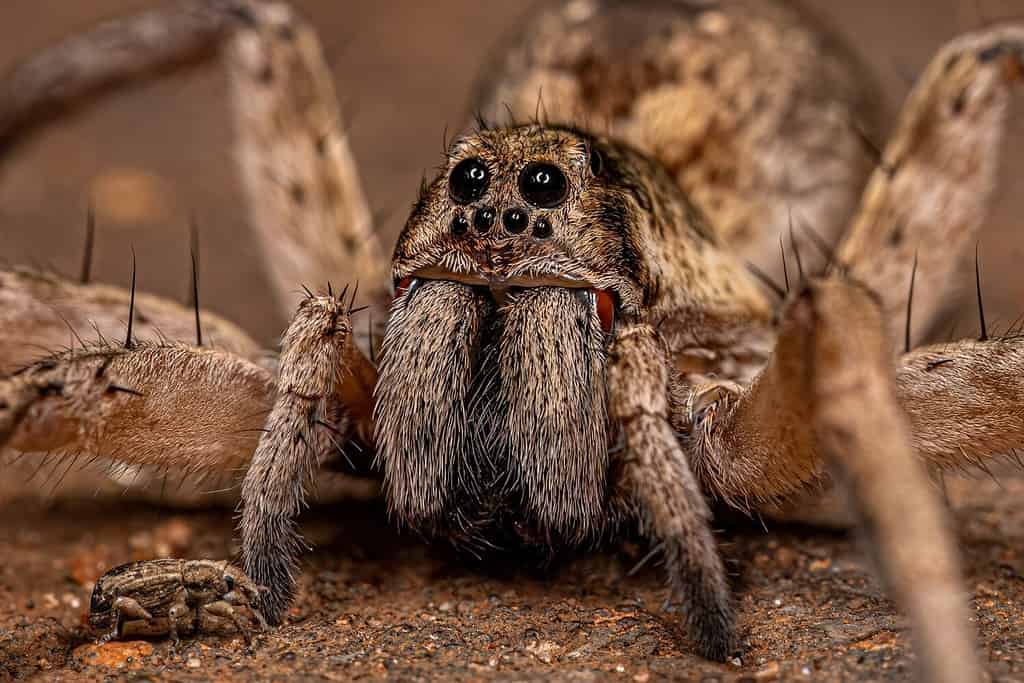
While wolf spiders may look absolutely terrifying, they’re actually not as dangerous as they look.
©Vinicius R. Souza/Shutterstock.com
Wolf spiders are quite the creatures with their fuzzy, pear-shaped bodies and long legs. They can show off various colors from brown and gray to black, often with stripes of white or yellow. These spiders can range from 0.2 to 1.2 inches, with females outsizing the males.
In terms of habitat, wolf spiders aren’t too picky about where they live, making homes in deserts, grassy areas, and even our neighborhoods, but they do love spots with lots of insects to eat.
Surprisingly and terrifyingly, wolf spiders can move quite fast when they need to, especially when it comes to food. Like jumping spiders, wolf spiders are all about the hunt, going after insects, other spiders, and sometimes small mammals. Their hunting style is often likened to that of wolves, from which they get their name. Wolf spiders use their sharp eyes and vibrations to detect prey, after which they will either pounce or chase them down at lightning speed. Once the prey is caught, the wolf spider will inject venom to liquefy its organs.
While technically venomous, wolf spiders are not toxic to humans. So, while they may look scary, there’s no need to panic!
8. Common House Spider (Parasteatoda tepidariorum)
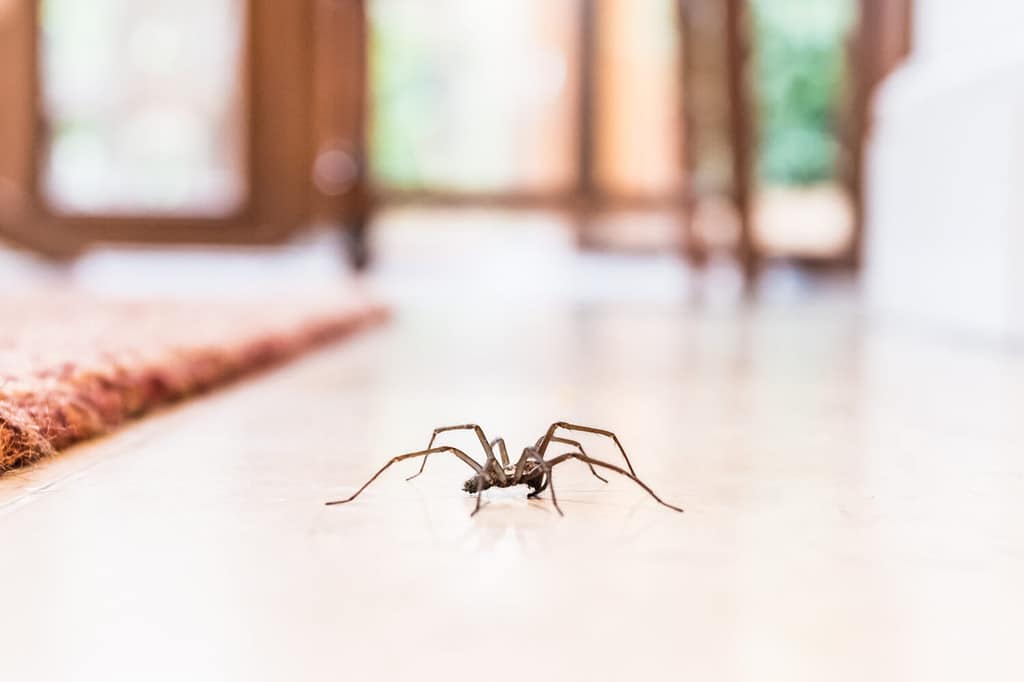
One spider you may see often in your San Diego home is the common house spider.
©Christine Bird/Shutterstock.com
The common house spider, also known as the American house spider, is a relatively small arachnid, with adults only measuring around 0.15 to 0.25 inches long. These spiders are generally tan to almost black in color. They might even have some patterning on their bodies that helps them blend in. As their name suggests, common house spiders love human-made structures and often set up their homes in our living spaces. More likely than not, these are the artists behind those tangled webs you might find inside your house or in structures like sheds and barns.
In terms of diet, common house spiders generally eat pesky household bugs like flies and ants. While they do technically have venom, there’s good news. It won’t hurt us, and these spiders rarely bite unless they feel threatened.
Summary of the Spiders Crawling Around San Diego
| Number | Spider | Scientific Name | Venomous? |
|---|---|---|---|
| 1. | Black Widow | Latrodectus hesperus | Yes |
| 2. | Brown Widow | Latrodectus geometricus | Yes |
| 3. | Desert Recluse | Loxosceles deserta | Yes |
| 4. | Tarantulas | Theraphosidae | Yes |
| 5. | Johnson’s Jumping Spiders | Phidippus johnsoni | Yes |
| 6. | Orb Spiders | Araneidae | No |
| 7. | Wolf Spider | Lycosidae | No |
| 8. | Common House Spider | Parasteatoda tepidariorum | No |
The photo featured at the top of this post is © Theodore P. Webb/Shutterstock.com
Thank you for reading! Have some feedback for us? Contact the AZ Animals editorial team.







